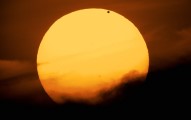Hola,
transcribo esta alerta de la AAVSO donde piden observaciones de este peculiar sistema eclipsante. Dichas observaciones consisten en fotometría continua (time-series) de la estrella, con poses de 600" como máximo y con un error no superior a 0.01-0.02 mag. Mejor poses de unos 60" si no implica sacrificar esa relaciñon S/N que piden.
Las observaciones deben comenzar ya y deberían concentrarse entre el 8 y 11 de agosto, momento en que se espera se produzca el eclipse.
Es un proyecto que se parece mucho al exitoso "b Per" en el que participé hace unos meses, con muy buenos resultados. Claro que hay un problema: b Per era muy brillante y con nuestros equipos normales no podía hacerse (me busqué la vida con una chapucilla práctica pero eficaz). Ahora el problema es justo el contrario: la estrella es muy débil (mag. 16 con filtro Johnson-V) y harán falta telescopios de al menos 20-30 cm y buenos cielos. Tanto es así que se aceptan medidas sin filtro.
Por mi parte no puedo observar ![]() esos días estoy fuera y aún no tengo el Meade a punto.
esos días estoy fuera y aún no tengo el Meade a punto.
Dejo la noticia por si alguien se anima. ![]()
Saludos
Fran
++++++++++++++++++++++++
The AAVSO requests time-series observations of the eclipsing binary
system KIC 02856960 beginning immediately, with intensive coverage
urgently requested during the window of 2015 August 8.0 through August
12.0. Observations are requested on behalf of an international campaign
coordinated by Dr. Thomas Marsh (University of Warwick) who is
attempting to explain the enigmatic behavior of this possible triple
system. CCD observers around the world are encouraged to participate,
since the observing program requires as complete temporal coverage as
can possibly be obtained. Observers in continental Asia and the Pacific
are especially encouraged to participate.
The object is located at the following (J2000) coordinates:
RA: 19 29 31.52 , Dec: +38 04 35.9
The star has an approximate V magnitude of around 16.0 (B-V ~ 0.85).
The short-period component of the system has regular eclipses with a
period of 0.2585082 days, and an eclipse depth of less than 0.015
magnitudes in V. This campaign is focused on the longer-period eclipses
which occur approximately every 204 days, with a depth of about 0.07
magnitudes. The properties of this system have not been successfully
modeled, and observations of this eclipse are strongly desired to
provide additional constraints for the modeling efforts. This is a
challenging campaign due to the small amplitudes involved (less than 0.1
magnitude) and the relative faintness of the target (V=16.0), but our
calculations suggest that the required precision should be achievable by
many AAVSO observers using CCD cameras and typical telescopes of 20cm
and larger.
Observers are asked to obtain photometry at the level of 1-2 percent
(0.01 to 0.02 magnitudes) or better, using net exposure times less than
600 seconds (10 minutes) total. For observers with larger apertures,
the use of filters is encouraged if the net exposure time per
measurement can be kept below 600 seconds, with the Ic and V filters
preferred in that order. Only one filter is needed, and observers may
take clear or unfiltered data if needed to reach the required S/N in
sufficient time. Exposures of 60 seconds are ideal, however, *please
note the following*: if you would otherwise combine multiple exposures
to create a stacked image with the requisite S/N within 600 seconds, the
researchers have asked that you submit measurements from the individual
frames instead. This will give the researchers additional flexibility
in averaging your observations together, even though your S/N per
measure might be lower than ideal.
Marsh and collaborators request as intense coverage as possible between
2015 August 8.0 (JD 2457242.5) and 2015 August 11.0 (2457245.5); the
eclipse event is currently predicted to begin around 2015 August 9.5 (JD
2457244.0) and to end around 2015 August 10.4 (2457244.9), and the
researchers would like at least a day's intensive coverage on either
side to better determine each observer's out-of-eclipse mean magnitude.
If possible, we strongly encourage additional time-series outside this
window, beginning as early as August 1, and continuing to at least
August 14 to provide additional information about the background
variations and mean light.
Charts for this object are available via AAVSO VSP:
The AAVSO Sequence Team has assigned a subset of Dr. Marsh's suggested
near-field comparison stars for this target that provide a reasonable
match to the variable's (g-r) color. Observers should use these
comparisons if at all possible; please clearly identify any and all
comparisons used in your report.
Observers are asked to promptly process their photometry and submit
their observations as normal via the WebObs feature on the AAVSO
website; please clearly indicate which comparison(s) were used and the
filter(s) used for the observation. Please use the name "KIC 02856960"
when submitting observations, including the leading zero ("0") in the
KIC identifier.
For more information and scientific background on this campaign, please
refer to the researchers' website at the following URL:
http://deneb.astro.warwick.ac.uk/phsaap/kic2856960/
This AAVSO Alert Notice was prepared by M. Templeton.
Meade LX200 12" Classic. Autoguiado Orión 80/400 + QHY6.
Newton Larrosa 200 f/4.7 sobre HEQ5 Syntrek. Autoguiado Orion Miniguider 50/162 + ASI 120 MM
Skywatcher 150mm f/5 sobre EQ5
Cámaras: SBIG ST-8XME para fotometría y postaleo
Atik 314L+ para postaleo y fotometría
ASI 120 MM para planetas y autoguiado
Filtros Astrodon BVRcIc (Johnson-Cousins) + rueda SXUFW-1T2
Prismáticos Vixen 7x50, ordenatas, cobertizo casero y otras cosicas...
Gracias fran por el aviso y por dejar traducido con detalles los requisitos de la AAVSO para esta obsrrvación. ![]()
Saludos
Luis
NEQ6 ProII Tuneada
SCT 11" - Mack 90 - EZG60
Atik 314L+ - QHY6
Vixen LV6mm.
Obs. St. Celoni MPC - B70 / AAVSO - PLMA


